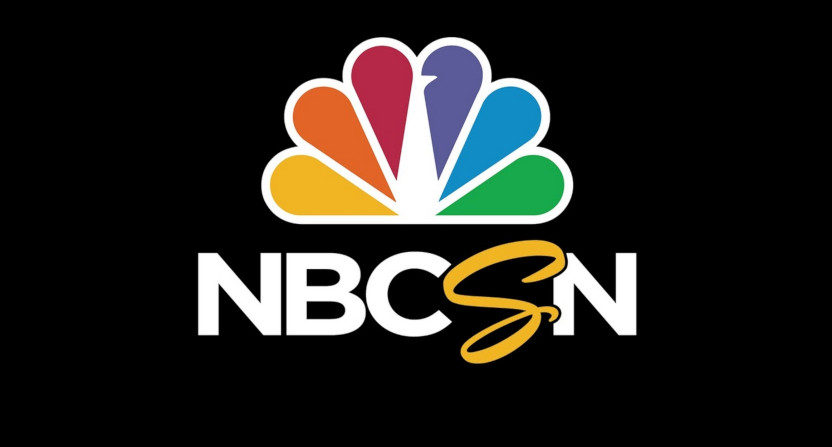Vast potential, underwhelming returns and a quiet retirement at the end of a serviceable but ultimately disappointing tenure – this isn’t the story of a lottery pick-turned-journeyman. This is the legacy of NBC Sports Network.
The channel goes dark commensurate with the New Year, almost a full decade to the day that the former Versus Network rebranded under the NBC banner on Jan. 2, 2012.
In hindsight, NBCSN (they fully adopted that shorter name beginning in the summer of 2013) could have, perhaps should have been the marketplace’s solid No. 2 cable sports outlet behind ESPN. The network seemingly had all it needed to flourish: a solid foundation taking over for the former Versus, a parent company with deep pockets and a brand with a track record for quality sports coverage.
A confluence of timing and luck instead have NBCSN where it is now, as both a relic of cable’s dwindling relevance and as a case of unmet potential.
IN THE BEGINNING, THERE WAS VERSUS
The brief existence of the Versus Network is a critical jumping-off point when evaluating NBC Sports Network – and not simply because the latter was rebranded from the former.
The change in branding only served as a small part in the transformation from Versus to NBCSN, as the two looked fundamentally different both in presentation and their lineups – though the offerings didn’t change entirely.
National Hockey League broadcasts were a tentpole in the NBCSN years, inherited after Versus (originally as the Outdoor Life Network) scooped up the league’s rights at bargain prices in 2005. The NHL was returning from a season-long lockout hiatus, which former ESPN/ABC Sports president George Bodenheimer cited in no uncertain terms as helping the Worldwide Leader move on from hockey.
“Given the prolonged work stoppage and the league’s TV ratings history, no financial model even remotely supports the contract terms offered,” he said in an August 2005 statement quoted by The New York Times.
Comcast-owned OLN stepped in with a deal paying $65 million, $70 million and $72.5 million over each of the contract’s first three years.
When the two sides renewed in 2008, Versus president Gavin Harvey told The New York Times NHL rights were “a game-changer” for the network, a statement supported in exponential subscriber growth from 10 to 70 million over three years.
As far as cornerstones, however, the NHL was the only bridge between eras.
Versus also relied heavily on college football and MMA as pillars, sports NBCSN dabbled in but never fully committed to in the years after the rebranding.
The growing prominence of UFC into the 2010s was perhaps inevitable with or without Versus – regional FOX Sports Network channels aired UFC pay-per-view and PRIDE Fighting replays in the 2000s, and CBS brought the short-lived EliteXC to network television in 2008 – but the fact remains that in 2010, Versus became the first basic cable channel to air a live UFC card.
That this occurred just 14 years after the late Sen. John McCain decried the sport as “human cockfighting,” and about 10 years from UFC’s nadir when it was running shows in places like Cedar Rapids and Lake Charles is nothing short of remarkable.
Versus also showcased Zuffa-owned World Extreme Cagefighting, helping to make a star of Urijah Faber and grow the popularity of lighter-weight MMA classes.
The drawing power of current fighters like Jose Aldo, T.J. Dillashaw and Max Holloway in the Featherweight and Bantamweight divisions is a legacy of both the defunct WEC, and Versus’ early investment in MMA.
Then came 2011, a pivotal year as the transition of Versus to NBCSN approached.
THE CONTRACTS OF 2011
A year before NBCSN officially launched, its parent entity completed a critical phase of a controversial merger with Comcast. Opponents decried the conflict of interest in a cable provider owning a considerable share of channels, and the possibility of it showing favoritism to its own properties while punishing competitors.
After the Federal Communications Commission laid out groundwork to assuage such concerns, and upon Comcast meeting a price tag of $13.75 billion, the merger became official on Jan. 29, 2011. Comcast became the sole owner in 2013, buying out the remaining 49 percent of ownership stake General Electric held in NBCUniversal.
The merger sparked optimism in the sports community.
“It’s an instant credibility in the sports world,” former IndyCar CEO Randy Bernard told the Associated Press in March 2011. “[NBCUniversal under the Comcast umbrella] understand what they want to grow the network, and that’s exciting to me.”
And IndyCar has indeed been a central part of the NBC Sports catalog in the decade since. It remains on the company’s streaming platform, Peacock, along with English Premier League and – this season, at least – the equivalent of Tier 3 Notre Dame football.
The NHL is not part of Peacock’s offering, however. The league’s partnership with NBC-via-Comcast ended at the conclusion of the 2020-21 season, the conclusion of a deal brokered in 2011.
Harvey’s declaration of NHL rights as “a game-changer” in 2008 proved true in 2011; the game had indeed changed. Less than three months after the Comcast/NBCUniversal merger, the NBC Sports Group announced a renewal with the NHL at $1.9 billion over 10 years. That was, per The New York Times, “15 to 20 percent” more than offers FOX and Turner offered.
Seven weeks after the April 2011 announcement of a renewed and far pricier NHL deal, NBC went back to the negotiating table on a property with an even heftier asking price.
Olympic broadcasts were long ratings bonanzas for NBC. Even as the 2010 Vancouver Winter Games lost money, the 2008 Beijing Games did monster numbers for the NBC family of networks.
NBC paid $4.38 billion to retain Olympic rights through the 2020 (and staged in 2021 due to COVID-19) Tokyo Games. The peacock again outbid FOX, this time by almost a full $1 billion per the Associated Press.
Two blockbuster deals made in the same year likely hamstrung NBC’s ability to lock up many other properties.
FOX, meanwhile, acquired properties in 2011 that contributed to the reshaping of Versus amid its NBC metamorphosis. In August, the FOX Sports Media Group announced its partnership with the UFC for $100 million a year.
In May 2011 – a most consequential month for NBC Sports with the resignation of longtime head Dick Ebersol – the then-future Pac-12 Conference revealed FOX as a co-partner with ESPN in what was then the largest rights deal in college sports history.
THE DEATH OF THE BIG EAST & BIRTH OF PAC-12 NETWORKS
The notion may seem foreign in the current landscape, but in 2011, the Pac-10 – still a few months from expanding to 12 – was a conference on a decided upswing.
The USC dynasty remained fresh in football fans’ minds, Oregon had a burgeoning national power with the innovative style introduced by Chip Kelly, and Stanford – under coach Jim Harbaugh, who just a few years prior was heading up non-scholarship University of San Diego – boasted a 2010 Heisman Trophy finalist in Andrew Luck who went into 2011 heavy favorite to win the award.
The Pac-10 at large, and Stanford in particular, played a significant role in the all-too-brief life of Versus college football coverage.
Over lunch at Pac-12 media days in 2015, Cardinal coach David Shaw went into detail with a group of reporters, including myself, on how Stanford’s win over USC in 2007 elevated the program from cellar-dweller to title challenger in just a few years.
Shaw was offensive coordinator of the Cardinal that night when, as 41-point underdogs, they stunned the perennial national championship-contending Trojans, 24-23. As other networks like ESPN cut in with updates on the contest, Shaw said he was told stories of viewers frantically changing the channel to see the Cardinal do the impossible.
Versus aired the impossible.
The network offered a refreshing mix of coverage on football Saturdays, with the Pac-10 and Big 12 – games from the latter included a Colt McCoy-led Texas team in 2009 that played for the national championship – as well as Mountain West and the Football Championship Subdivision.
ESPN doesn’t have a monopoly on college football; it only feels that way sometimes, and has for quite awhile. It’s becoming more encompassing commensurate with the launch of the College Football Playoff and the Worldwide Leader’s exclusive rights ownership, but even in the 2000s, existed enough that Versus broadcasts offered a welcomed change of pace.
Versus offered refuge from the purgatory of FSN regional networks, where Tier 3 Pac-10 and Big 12 games lived in the Aughts.
NBCSN initially looked to be intent on continuing its college football coverage after the rebrand, but the Pac was not to be in the mix.
In May 2011, the conference unveiled a then-record-setting $3 billion partnership with both ESPN and FOX, as well as the launch of its own network. Early reports of the Pac’s owned-and-operated channel suggested it would be a digital service – that sound you hear is the collective grumblings of millions still unable to access Pac-12 Networks today.
No matter digital or linear, however, the Pac moved into new ventures just before NBCSN’s launch. NBCUniversal brass turned to the Big East a year later in what remains one of the more uncertain and uglier chapters in television’s ever-growing dominion over college football.
Former Big East commissioner John Marinatto said at the conference’s media days in 2011 that the Pac-12 had “reset the marketplace.” As a result, the Big East sought broadcast opportunities beyond ESPN, leading to promising flirtations with NBC despite the exits of Syracuse and Pitt for the ACC, West Virginia for the Big 12, and (before ever officially joining) TCU.
Notre Dame football has long been a cornerstone of NBC programming, enduring down periods in the program’s play, changes in leadership at the network, and changing telecommunicative technologies.
With Notre Dame, a member in every other Big East sport, building an entire football offering around the staple of the Fighting Irish just made sense for all parties.
But as negotiations commenced, conference realignment hit the Big East relentlessly and on a dizzying timeline.
Aug. 7, 2012: New York Daily News reports NBC Sports Group will offer the Big East $10 million per team per year, and $4 million for each of the conference’s men’s basketball members.
Sept. 12: Notre Dame announces its departure for the ACC.
Nov. 20: Rutgers, while in competition for the Big East Conference football championship, announces it is joining the Big Ten.
Nov. 28: Louisville announces its exit for the ACC, six weeks before Teddy Bridgewater quarterbacks the Big East champion Cardinals to a Sugar Bowl defeat of Florida.
Dec. 31: Boise State opts not to join the Big East, a move announced the year prior.
Jan. 16, 2013: San Diego State follows Boise State in remaining committed to the Mountain West.
By February, NBC’s offer plummeted to $20 million a year for six years, a bargain-basement price that ESPN opted to match. The chess match checkmated Big East football altogether, leading to the splintering of its non-FBS football-playing members and the remaining core that rebranded as the American.
Had the Big East remained in tact, NBCSN might have showcased Lamar Jackson’s run to the Heisman, two Final Four-winning Villanova basketball teams, and perhaps factored into the negotiations for College Football Playoff rights.
The third point is purely speculative, but it is a fascinating idea to ponder as ESPN enters its eighth postseason with exclusive ownership of the championship.
Read on for discussion of how FS1 impacted NBCSN, NBCSN studio programming, and where NBC’s sports content is going now.







